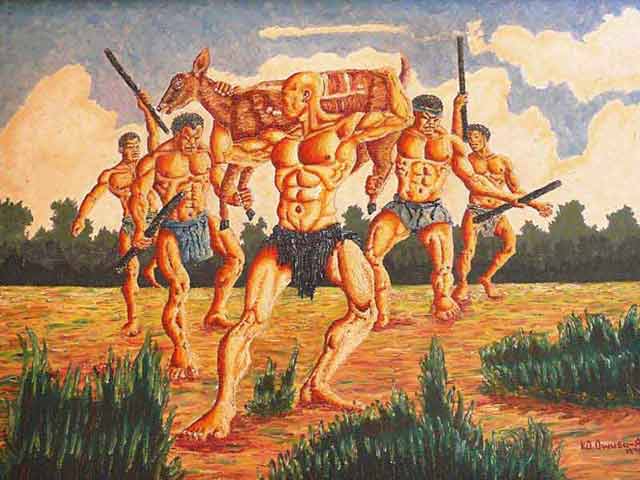An energetic scene. Five men in a flat landscape approach the viewer. Their bodies are naked - except for their loincloths - their faces grim. Muscles in the bright light stand out under the skin, their chests bulge voluminously - they are timeless heroes. The men do not look at the viewer of the picture. With their long, dark sticks firmly in their strong hands, they gather symmetrically around the bald man in the foreground. He presents himself with an antelope in his raised arms. His bald skull points to the left, as does the antelope's head.
On closer inspection, some things are irritating. Are the men dancing or walking? Where is the animal spatially located? Somehow it is on the shoulder of the man, but the legs are captured by the men behind, who would be much too far away for that. Is an event, an episode (as in a photograph) depicted? Or does the symmetry of the composition speak more of a constructed symbol, a sign, as in an emblem? The latter would support the strict division into horizontal planes: with the islands of grass in the foreground, the flat, ochre-coloured plane in the middle ground and the forest with sky in the background. But then again many design principles undermine this order: the tense, energetic movements of the figures, the strong brushstrokes, the irregular shapes of the white clouds and the tufts of grass, the dynamic accents of the sticks.
We know from our Ghanaian colleagues that what is depicted here, the catching of the animal, is part of a ritual celebration and a festival (the Aboakyer Festival). Here the moment is shown when the men have stepped out of the dark, hermetically sealed forest in the background with their prey and now present themselves in the bright light with their success. A comparison with the results of an image search on the internet for “Aboakyer festival” (Fig. 2) shows that this is the iconic moment. Here the idea of the festival seems to be condensed. And this also explains the emphasis on muscles: the hunters must be well trained to match the animal's speed and strength.

Fig. 2 (Google search for "Aboakyer Festival" on 9.9.2023 - the first page of results) Screenshot: Ernst Wagner
Owuso-Ankomah's painting focuses on the men with the animal. At first glance, the painting shows above all the strength of the men. The space thus becomes the backdrop for their performance. Their bodies are not only idealised but theatrically exaggerated, their muscles as if illuminated by a spotlight. The geometric centre of the picture, through which the horizon also passes, brings the loincloth of the leader into focus (see fig. 3) - perhaps an allusion to male potency?

Fig. 3: Composition sketch (horizon and geometric centre) Photo: Ernst Wagner
A comparison with photos on the same theme from the Heritage Centre in Winneba (see Fig. 4-6) shows clear differences to the depiction in Owusu-Ankomah's painting. In the artwork, both animal and hunter have their mouths open, exhaustion is evident in both. In this way, too, man, animal and landscape are connected - despite hunting and death. The artist uses the warm ochre tones in such a way that the earth, the human body and the animal hardly differ in colour. Since the animal is still alive, its head does not have to be held. Thus, visually, it seems to elude a depiction of "being trapped", also due to the ambiguous spatiality described above. It could almost just as easily be understood as a triumphant appearance of the animal, to which the men are subordinate as bearers and assistant figures - comparable, for example, to Jan van Eyck's depiction of the lamb (see fig. 7), which also marks a mediating position between victim and victor, between human beings and God.

Fig. 4-6: Photos from the Heritage Centre Winneba Photos: Ernst Wagner

Fig. 7: Van Eyck, Lamb of God, Image Detail: Ghent Altar. Oil on wood, 350 x 461 cm
Cathedral of St Bavo, Ghent
https://commons.wikimedia.org/w/index.php?curid=109213 [28.10.2024]
This image sets against each other contradictory concepts: static-symmetrical-ordered vs. dynamic; accidental situation vs. deliberate staging; documentation vs. sign; hyperrealism in body and space vs. symbolic charge. It sets these contradictions against each other in the unity of the painting.
Reference
Published March 2024








